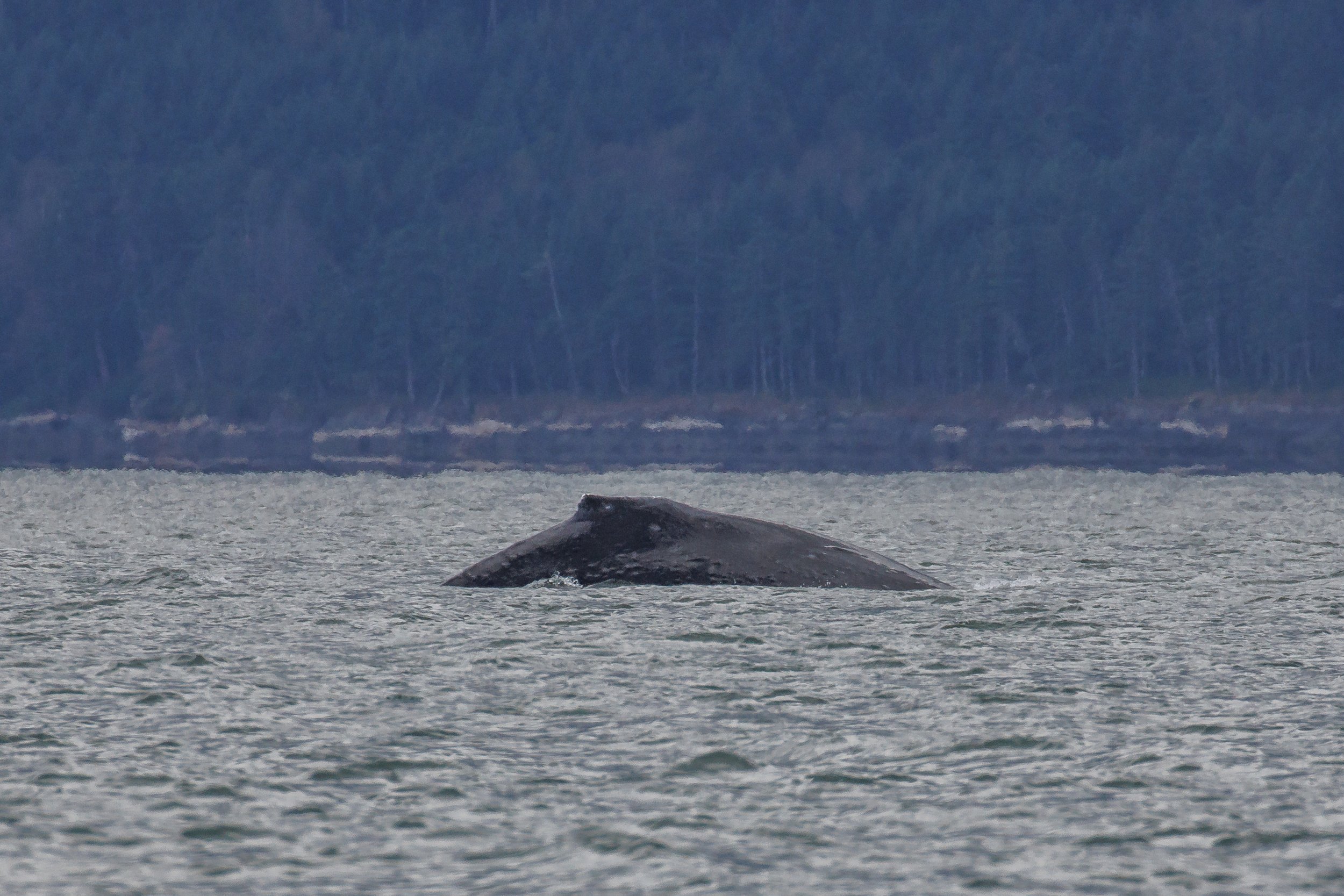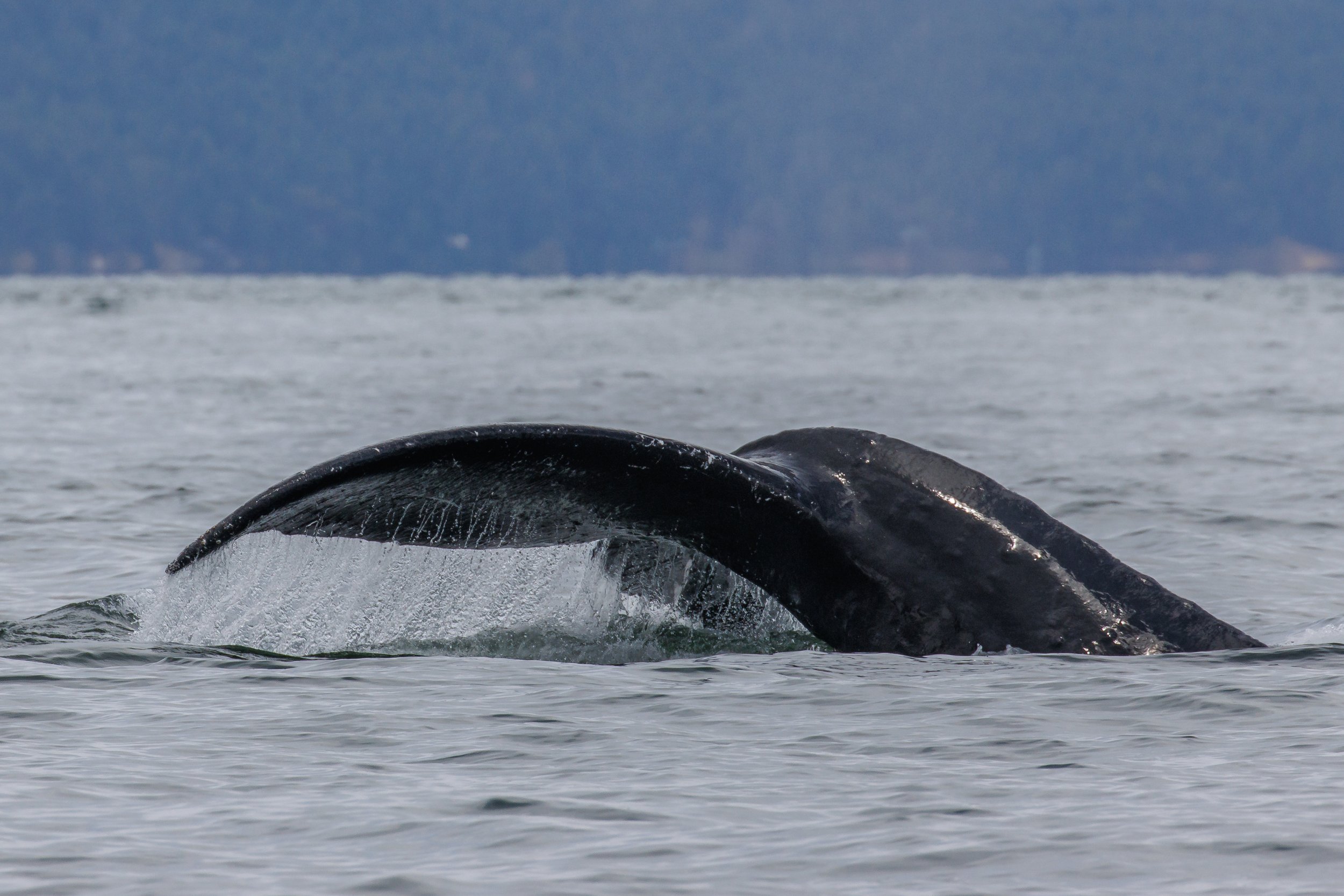June 18, 2023, 10:30 AM - Humpback whales Windy and Fader
This morning, our open boats Cascadia and Keta headed south through the Gulf Islands to start our search for the day. We ended up just east of Porlier Pass, where we had a lovely encounter with two well-known Humpbacks in our area- BCY0195 Fader and BCY0893 Windy. Both of these Humpbacks are part of the Hawaii population that visits our waters, enjoying the warm shallows waters there before heading to our colder region. These cold waters are perfect for the humpbacks to feed. Temperature is one of the things that affect oxygen saturation levels in the water, meaning the colder it is, the more oxygen can be dissolved in the water. Since a lot of organisms use oxygen higher levels typically mean high biodiversity and productivity. This high productivity is actually why our humpbacks spend their summers here, its all for the food.
The entire time they are up here they will be feeding and building their fat reserves. When they return to the warmer Hawaiian waters they will only feed very opportunistically, but most of their energy comes from metabolizing their fat stores. Especially for Windy, who is a known male through most photos of his genital region and through biopsy samples. Males down in the breeding grounds will expend a ton of energy through surface activities as they show off their fitness and compete for the ladies.
Did you know that a single breach from an adult humpback whale is about equivalent to a human running an entire marathon? That’s why when they first return surface activity is less common, since they just burned through all their fat over the winter and have to build it back up again to prepare for next year.
Every day a humpback whale consumes up to 1.5 tons of food to help build their reserves. That’s millions of the tiny animals that are on the menu for our humpbacks!
Today feeding is exactly what we think these two were doing. When we first arrived these two whales were travelling separately doing the deeper feeding dives, but then over time they got closer together and may have been interacting! Fader was even doing what was close to a tail flick a few times as they socialized.
All the photos from the day were taken by our onboard naturalists Aly Kohlman and Vanessa Vereschahen and can be enjoyed below!
Windy going for a feeding dive. Photo by Aly Kohlman.
The underside of Windy’s tail flukes. Photo by Aly Kohlman.
Windy surfacing with Valdes Island in the background. Photo by Aly Kohlman.
Windy showing off his tail flukes. Photo by Aly Kohlman.
Faders dorsal fin in the distance as they prepare to dive. Photo by Aly Kohlman.
Cascadia in the moody weather. Photo by Aly Kohlman.
Fader going for a dive. Look at all those bumps on their sides. Photo by Aly Kohlman.
Fader with a mini tail flick! Photo by Aly Kohlman.
Windy’s nostrils and dorsal fins. Photo by Aly Kohlman.
Fader’s Dorsal fin. Photo by Aly Kohlman.
Fader going for a dive. Photo by Aly Kohlman.
Fader Diving. Photo by Aly Kohlman.
Windy preparing to dive, can you notice his new entanglement scarring? Photo by Vanessa Vereschahen.
Right up Windy’s nostrils. Photo by Vanessa Vereschahen.
A fried egg jellyfish near Stinky Rock. Photo by Vanessa Vereschahen.
A Bald Eagle perched on a navigational marker. Photo by Aly Kohlman.
A large male Steller Sea Lion giving the others an earful. Photo by Vanessa Vereschahen.
Stinky rocks. Photo by Vanessa Vereschahen.
Sleepy time on Stinky Rocks. Photo by Aly Kohlman.
Photo by Aly Kohlman.
A couple of Harbour Seals. Photo by Aly Kohlman.
Harbour Seal making its way up the rocks. Photo by Aly Kohlman.
We’ve nicknamed this Juvenile Bald Eagle on Gabriola Island “Pinecone”! Photo by Aly Kohlman.
Some Sea Stars surrounded by anemones. Photo by Aly Kohlman.
Pigeon Guillemot near the bluffs. Photo by Aly Kohlman.
Showing off his wings! Photo by Vanessa Vereschahen.
Another moody shot of the rain in the distance. Photo by Vanessa Vereschahen.



























